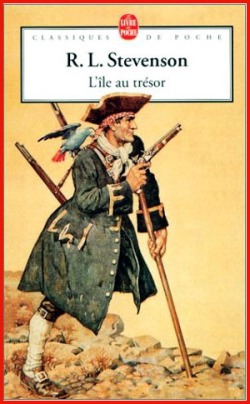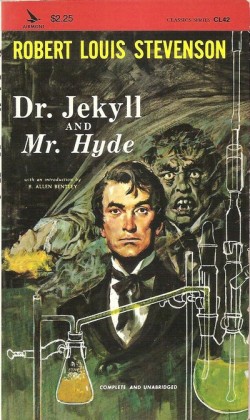 Treasure Island (1883) and Dr. Jekyll and Mr. Hyde (1885), Robert Louis Stevenson
Treasure Island (1883) and Dr. Jekyll and Mr. Hyde (1885), Robert Louis Stevenson
These two books contain two of the greatest stories ever written. But they’re curiously different in style, despite the brief time that separates them. Treasure Island has deep pages, Dr. Jekyll and Mr. Hyde has shallow ones – paper-thin, you might say. In the former, the prose vividly evokes the sounds, sights and smells of the eighteenth century: there’s a three-dimensional world beneath the words and you read almost as though you’re looking into an aquarium. When you’ve finished the story, you feel as though you’ve lived it, as though you’ve really met the characters who moved through it, really had the adventures that Jim Hawkins describes. Dr. Jekyll and Mr. Hyde isn’t like that. I read it, I don’t live it, because the words don’t transcend language and I don’t forget the printed page as I do in Treasure Island. The closest the story comes to conjuring a moment of reality is perhaps here:
They mounted the stair in silence, and still with an occasional awe-struck glance at the dead body, proceeded more thoroughly to examine the contents of the cabinet. At one table, there were traces of chemical work, various measured heaps of some white salt being laid on glass saucers, as though for an experiment in which the unhappy man had been prevented.
“That is the same drug that I was always bringing him,” said Poole; and even as he spoke, the kettle with a startling noise boiled over.
This brought them to the fireside, where the easy-chair was drawn cosily up, and the tea-things stood ready to the sitter’s elbow, the very sugar in the cup. (Dr. Jekyll and Mr. Hyde, “The Last Night”)
It’s a clever domestic touch amid the horror that has gone before and the horror that is to come. But Treasure Island is full of touches like that, bringing the world of the story before the mind’s eye or ear or nose: the notch in the “big signboard of Admiral Benbow”, left by Bill’s cutlass as he aims a blow at Black Dog; the “five or six curious West Indian shells” in Bill’s sea-trunk and the “piece of pigtail tobacco bitten away at the end” in his pocket; the “smell of sodden leaves and rotting tree trunks” at the Hispaniola’s first anchorage; the death-shriek that sends marsh-birds whirring aloft when a loyal sailor is murdered; O’Brien’s red cap floating on the surface and the baldness of his bare head beneath the rippling water; Long John Silver’s parrot’s “pecking at a piece of bark” in the dark; the “wood ash” on the black spot handed to Silver, which soils Jim’s fingers; the “heavy-scented broom and many flowering shrubs” on Spy-glass Hill; the grass sprouting on the bottom of the “great excavation” where Flint’s treasure had been; the “strange Oriental” coins “stamped with what looked like wisps of string or bits of spider’s web”; and many more.
The characterization is excellent too. Treasure Island is full of memorable figures, cleverly seen from (mostly) a boy’s perspective: Bill, Blind Pew, the Squire, Ben Gunn, Israel Hands and, most memorable of all, Long John Silver, the charming backstabber and affable rogue. They’re good, evil, pathetic, frightening, cunning, stupid, murderous, brave and more. Hands’ mind and motives are captured in a single line: “I want their pickles and wines, and that.” And here’s Ben Gunn’s long exile evoked in tragicomic dialogue: “Well, many’s the long night I’ve dreamed of cheese — toasted, mostly — and woke up again, and here I were.”

The characters in Dr. Jekyll and Mr. Hyde don’t live on the page like that: Hyde is described as evil, but he isn’t frightening like Blind Pew. Hyde is words on a page; Pew wrenches arms and skips nimbly from the parlour of the Admiral Benbow. His stick goes “tap-tapping” on a “frozen road”. He lives, and dies, before the mind’s eye. But one thing the characters of the two books have in common is that they’re almost all male. There’s a cook and a housemaid in Jekyll and Hyde, Jim’s mother and Silver’s “old Negress” in Treasure Island, and that’s it, unless you count the Hispaniola, Silver’s parrot and the sea.
This paucity of female characters links Dr. Jekyll and Mr. Hyde with Oscar Wilde’s The Picture of Dorian Gray (1890) and Herman Melville’s Billy Budd (1924). Those two books also have shallow pages. Billy Budd, in fact, is the shallowest book I’ve ever come across. All I found in it was words conjuring nothing: there were no sounds, sights or smells to the story:
The lieutenants and other commissioned gentlemen forming Captain Vere’s staff it is not necessary here to particularize, nor needs it to make any mention of any of the warrant-officers. But among the petty-officers was one who having much to do with the story, may as well be forthwith introduced. His portrait I essay, but shall never hit it. This was John Claggart, the Master-at-arms. But that sea-title may to landsmen seem somewhat equivocal. Originally, doubtless, that petty-officer’s function was the instruction of the men in the use of arms, sword or cutlas. But very long ago, owing to the advance in gunnery making hand-to-hand encounters less frequent and giving to nitre and sulphur the preeminence over steel, that function ceased; the Master-at-arms of a great war-ship becoming a sort of Chief of Police, charged among other matters with the duty of preserving order on the populous lower gun decks. (Billy Budd, chapter 8)
I found the book boring and a chore to read. That’s not true of Stevenson’s and Wilde’s stories, which are both about temptation and damnation. But the reality conjured by those two authors is almost a theatrical one, as though the characters are on a stage surrounded by props and special effects:
It was a wild, cold, seasonable night of March, with a pale moon, lying on her back as though the wind had tilted her, and a flying wrack of the most diaphanous and lawny texture. The wind made talking difficult, and flecked the blood into the face. It seemed to have swept the streets unusually bare of passengers, besides; for Mr. Utterson thought he had never seen that part of London so deserted. (Dr. Jekyll and Mr. Hyde, “The Last Night”)
The wind shook some blossoms from the trees, and the heavy lilac-blooms, with their clustering stars, moved to and fro in the languid air. A grasshopper began to chirrup by the wall, and like a blue thread a long thin dragon-fly floated past on its brown gauze wings. Lord Henry felt as if he could hear Basil Hallward’s heart beating, and wondered what was coming. […] “How horribly unjust of you!” cried Lord Henry, tilting his hat back and looking up at the little clouds that, like ravelled skeins of glossy white silk, were drifting across the hollowed turquoise of the summer sky. […] There was a rustle of chirruping sparrows in the green lacquer leaves of the ivy, and the blue cloud-shadows chased themselves across the grass like swallows. (The Picture of Dorian Gray, chapter 1)
Lord Henry ponders the “subtle magic” of language and asks himself: “Was there anything so real as words?” Yes, I would say, and things more real too, but the attempted paradox is a reminder that Wilde is not striving for realism. I don’t think he could have achieved it as Stevenson could and often did. Stevenson was a better writer, but The Picture of Dorian Gray is a more fully realized book. It’s longer, after all. Dr. Jekyll and Mr. Hyde is as short as the dream or nightmare it resembles: it offers the ingredients for horror, but you have to cook some of them for yourself. Treasure Island isn’t a dream: it’s an aquarium or a magic mirror. All three are books to return to again and again over a lifetime, but for me Stevenson’s literary stature seems to grow, Wilde’s to shrink, each time I do so.